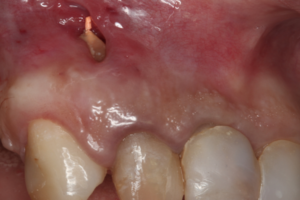Artigo revisita os momentos que nos trouxeram às condutas clínicas para a preservação do rebordo alveolar em alvéolos frescos de extração.
AUTOR
Paulo Henrique Orlato Rossetti
Cirurgião-dentista, mestre e doutor em Reabilitação Oral – FOB-USP.
Orcid: 0000-0002-0868-6022.
RESUMO
Objetivo: revisitar os momentos que nos trouxeram às condutas clínicas para a tão falada preservação do rebordo alveolar em alvéolos frescos de extração. Material e métodos: uma busca foi realizada em mais de 20 periódicos científicos, acessados número por número, apenas no ano de 2003. Resultados: três artigos foram escolhidos como os mais representativos deste tópico. O primeiro avaliou em humanos a largura do rebordo alveolar antes e após extrações dentárias seguidas de radiografias periapicais com técnicas de subtração digital no exame das mudanças ósseas em um ano. De modo geral, a média de variação em largura no rebordo ficou em 6 mm, com os níveis ósseos do centro do alvéolo posicionando-se abaixo das regiões proximais, e a altura óssea variou significativamente nos primeiros três meses. O segundo comparou uma combinação de biomateriais (FDBA + tetraciclina + membrana colágena) ou não nos alvéolos não molares de extração em humanos, com biopsia e colocação tardia do implante. A perda em largura do rebordo ósseo foi maior sem a combinação dos biomateriais, que também proporcionaram ganho de altura na crista óssea e maior quantidade de osso formado. Por fim, o terceiro estudo analisou em detalhes (regiões marginal, central e apical) a cicatrização do alvéolo experimental pós-extração em cães por nove períodos temporais diferentes, verificando que o grau de mineralização no alvéolo diminuiu drasticamente após 180 dias, concomitante à formação de uma ponte de osso cortical na sua porção coronal. Conclusão: novos insights biomecânicos foram obtidos na tentativa de preservação do contorno vestibular do rebordo alveolar pós-extração.
Palavras-chave – Preservação alveolar; Alvéolo fresco de extração; Osseointegração; Implantodontia.
ABSTRACT
Objective: to revisit the moments that led us to the clinical strategies on the so-called alveolar ridge preservation for fresh extraction sockets. Material and methods: a search was made through mor than 20 scientific periodicals, accessed number by number, but only in the year 2003. Results: three articles were selected as the most representative of this topic. The first evaluated in humans the alveolar ridge width before and after tooth extractions followed by periapical radiographs with digital subtraction technique to examine bone changes until 1 year later. Overall, the mean change on alveolar width was 6 mm, with the center of the alveolus remaining below the proximal vertical levels; the bone height varied significantly in the first three months. The second compared combined biomaterials (FDBA + tetracycline & collagen membrane) or not at the non-molar alveolar extraction socket in humans, with further biopsy and late implant placement. The loss of alveolar width was greater in the socket alone, with the biomaterials providing bone crest gain and more vital bone. Finally, the third analyzed in details (marginal, central, and apical parts) the healing at the experimental alveolar unity in dogs after 9 time periods, observing that the degree of alveolar mineralization decreased sharply after 180 days concomitant to the bone bridge formed to seal the coronal portion of the socket. Conclusion: new biomechanical insights were generated as an attempt to preserve the buccal contours of the fresh-extraction alveolar sockets.
Key words – Alveolar preservation; Extraction socket; Implant dentistry; Osseointegration.
Referências
- Garant PR. Oral tissues and cells. Chicago: Quintessence, 2003. p.2.
- Van der Linden FPGM. Crescimento e ortopedia facial. São Paulo: Quintessence Books 1990. p.105-57.
- Bernard JP, Schatz JP, Christou P, Belser U, Kiliaridis S. Long-term vertical changes of the anterior maxillary teeth adjacent to single implants in young and mature patients. A retrospective study. J Clin Periodontol 2004;31(11):1024-8.
- Fejerskov O, Mjor IA. Embriologia e histologia oral humana. São Paulo: Panamericana, 1990.
- Schroeder HE. The Periodontium. Berlin: Springer-Verlag, 1986.
- Wolff J. The laws of bone remodeling. Berlin 1986 (originalmente publicado em 1892).
- Euler H. Die heilung von extraktionswuden. Deustch Monasch. Zahnk 1923;41:685.
- Meyer W. Die heilung von extraktionswuden unter abormen verhaltnissen. Ztschr Stomatol 1924;22:521.
- Schram WR. A histology study of repair in the maxillary bones following surgery. J Am Dent Assoc 1929;16:1987-97.
- Claflin RS. Healing of disturbed and undisturbed extraction wounds. J Am Dent Assoc 1936;23:945-59.
- Amler MH, Johnson PL, Salman I. Histological and histochemical investigation of human alveolar socket healing in undisturbed extraction wounds. J Am Dent Assoc 1960;61:32-44.
- Amler MH. The time sequence of tissue regeneration in human extraction wounds. Oral Surg Oral Med Oral Pathol 1969;27:309-18.
- Pietrokovski J, Massler M. Alveolar ridge resorption following tooth extraction. J Prosthet Dent 1967;17(1):21-7.
- Boyne PJ. Osseous repair of the post extraction alveolus in man. Oral Surg Oral Med Oral Pathol 1966;21(6):805-13.
- Pinto VS, Couy KC, Pinto MNS, Paulon P. Tratamento do complexo mucoso alveolar imediato à extração. In: Rossetti PHO, Bonachela WC (eds). 50 anos de osseointegração: reflexões e perspectivas. São Paulo: VM Cultural, 2015.
- Schropp L, Wenzel A, Kostopoulos L, Karring T. Bone healing and soft tissue contour changes following single tooth extraction: a clinical and radiographic 12-month study. Int J Periodontics Restorative Dent 2003;23(4):313-23.
- Iasella JM, Greenwell H, Miller RL, Hill M, Drisko C, Bohra AA et al. Ridge preservation with freeze-dried bone allograft and a collagen membrane compared to extraction alone for implant site development: a clinical and histologic study in humans. J Periodontol 2003;74(7):990-9.
- Cardaropoli G, Araujo M, Lindhe J. Dynamics of bone tissue formation in tooth extraction sites. An experimental study in dogs. J Clin Periodontol 2003;30(9):809-18.
- Quayle AA. Atraumatic removal of teeth and root fragments in dental implantology. Int J Oral Maxillofac Implants 1990;5(3):293-6.
- Chen ST, Wilson Jr. TG, Hämmerle CHF. Immediate or early placement of implants following tooth extraction: review of biologic basis, clinical procedures, and outcomes. Int J Oral Maxillofac Implants 2004;19(suppl.):12-25.




